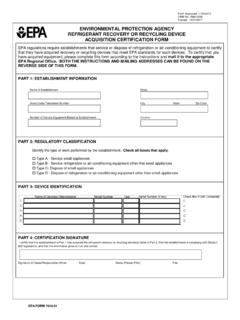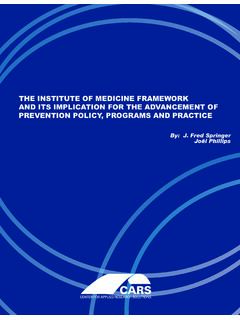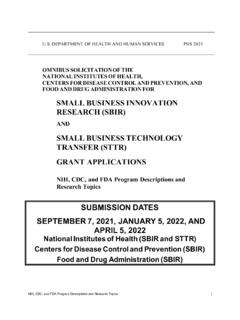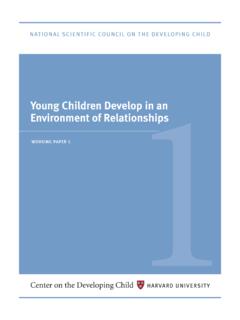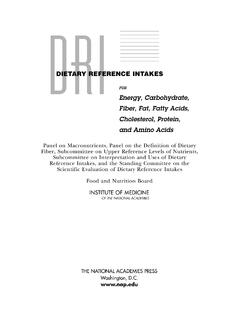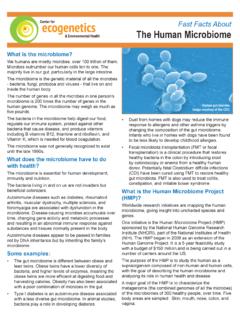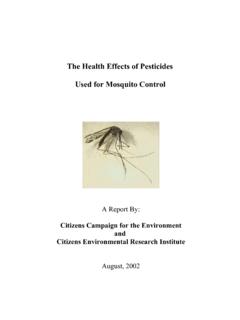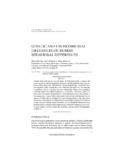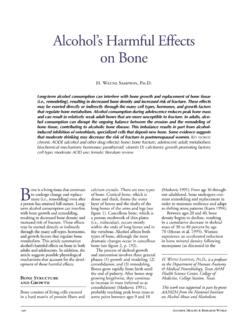Transcription of Formaldehyde - United States Environmental Protection …
1 Formaldehyde 50-00-0 Hazard Summary Formaldehyde is used mainly to produce resins used in particleboard products and as an intermediate in the synthesis of other chemicals. Exposure to Formaldehyde may occur by breathing contaminated indoor air, tobacco smoke, or ambient urban air. Acute (short-term) and chronic (long-term) inhalation exposure to Formaldehyde in humans can result in respiratory symptoms, and eye, nose, and throat irritation. Limited human studies have reported an association between Formaldehyde exposure and lung and nasopharyngeal cancer.
2 Animal inhalation studies have reported an increased incidence of nasal squamous cell cancer. EPA considers Formaldehyde a probable human carcinogen (Group B1). Please Note: The main sources of information for this fact sheet are EPA's Health and Environmental Effects Profile for Formaldehyde (1) and the Integrated Risk Information System (IRIS) (6), which contains information on oral chronic toxicity and the RfD, and the carcinogenic effects of Formaldehyde including the unit cancer risk for inhalation exposure. Uses Formaldehyde is used predominantly as a chemical intermediate.
3 It also has minor uses in agriculture, as an analytical reagent, in concrete and plaster additives, cosmetics, disinfectants, fumigants, photography, and wood preservation. (1,2 ) One of the most common uses of Formaldehyde in the is manufacturing urea- Formaldehyde resins, used in particleboard products. (7) Formaldehyde (as urea Formaldehyde foam) was extensively used as an insulating material until 1982 when it was banned by the Consumer Product Safety Commission. ( 1,2 ) Sources and Potential Exposure The highest levels of airborne Formaldehyde have been detected in indoor air, where it is released from various consumer products such as building materials and home furnishings.
4 One survey reported Formaldehyde levels ranging from to parts per million (ppm) in homes. Higher levels have been found in new manufactured or mobile homes than in older conventional homes. (1) Formaldehyde has also been detected in ambient air; the average concentrations reported in urban areas were in the range of 11 to 20 parts per billion (ppb). The major sources appear to be power plants, manufacturing facilities, incinerators, and automobile exhaust emissions. ( 7) Smoking is another important source of Formaldehyde . (1) Formaldehyde may also be present in food, either naturally or as a result of contamination.
5 ( 1) Assessing Personal Exposure Blood levels of Formaldehyde can be measured. However, these measurements are only useful when exposure to relatively large amounts of Formaldehyde has occurred. ( 2) Health Hazard Information Acute Effects: The major toxic effects caused by acute Formaldehyde exposure via inhalation are eye, nose, and throat irritation and effects on the nasal cavity. Other effects seen from exposure to high levels of Formaldehyde in humans are coughing, wheezing, chest pains, and bronchitis. (1,2 ) Ingestion exposure to Formaldehyde in humans has resulted in corrosion of the gastrointestinal tract and inflammation and ulceration of the mouth, esophagus, and stomach.
6 ( 1,2 ) Acute animal tests in rats and rabbits have shown Formaldehyde to have high acute toxicity from inhalation, oral, and dermal exposure. (3) Chronic Effects (Noncancer): Chronic exposure to Formaldehyde by inhalation in humans has been associated with respiratory symptoms and eye, nose, and throat irritation. (1,2 ,4,5) Repeated contact with liquid solutions of Formaldehyde has resulted in skin irritation and allergic contact dermatitis in humans. (5) Animal studies have reported effects on the nasal respiratory epithelium and lesions in the respiratory system from chronic inhalation exposure to Formaldehyde .
7 (1,2,4,5) The Reference Dose ( RfD) for Formaldehyde is milligrams per kilogram body weight per day (mg/kg/d) based on a decrease in body weight gain and effects on the stomach in rats. The RfD is an estimate (with uncertainty spanning perhaps an order of magnitude) of a daily oral exposure to the human population (including sensitive subgroups) that is likely to be without appreciable risk of deleterious noncancer effects during a lifetime. It is not a direct estimator of risk but rather a reference point to gauge the potential effects. At exposures increasingly greater than the RfD, the potential for adverse health effects increases.
8 Lifetime exposure above the RfD does not imply that an adverse health effect would necessarily occur. ( 6) EPA has high confidence in the study on which the RfD was based since it consisted of an adequate number of animals of both sexes, as well as a thorough examination of toxicological and histological parameters; medium confidence in the database as several additional chronic bioassays and reproductive and developmental studies support the critical effect and study; and, consequently, medium confidence in the RfD. ( 6) EPA has not established a Reference Concentration ( RfC) for Formaldehyde .
9 (6) The Agency for Toxic Substances and Disease Registry (ATSDR) has established a chronic inhalation 3 minimal risk level (MRL) of ppm ( milligrams per cubic meter, mg/m ) based on respiratory effects in humans. The MRL is an estimate of the daily human exposure to a hazardous substance that is likely to be without appreciable risk of adverse noncancer health effects over a specified duration of exposure. (7) Reproductive/Developmental Effects: An increased incidence of menstrual disorders were observed in female workers using urea- Formaldehyde resins.
10 However, possible confounding factors were not evaluated in this study. ( 1,2) A study of hospital equipment sterilizing workers did not report an association between Formaldehyde exposure and increased spontaneous abortions. (1,2) Developmental effects, such as birth defects, have not been observed in animal studies with Formaldehyde . (1,2) Cancer Risk: Occupational studies have noted statistically significant associations between exposure to Formaldehyde and increased incidence of lung and nasopharyngeal cancer. This evidence is considered to be "limited," rather than "sufficient," due to possible exposure to other agents that may have contributed to the excess cancers.

